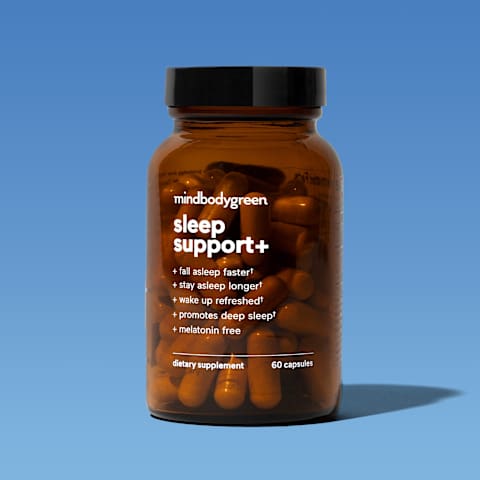Advertisement
A Nutrition Ph.D.'s Guide To Getting Enough Magnesium Every Day


Magnesium is an essential mineral that facilitates hundreds (yes, hundreds) of chemical reactions in the body to help support healthy bones, joints, blood pressure levels, blood sugar levels, and more.* So it's no surprise that our daily requirements for it are quite high. Depending on your age, daily magnesium needs1 range from 400 to 420 milligrams for adult men and 310 to 320 milligrams for adult women (with even more needed during pregnancy, up to 360 milligrams). Consistently reaching this threshold can be a challenge, but this daily game plan from nutrition scientist Ashley Jordan Ferira, Ph.D., RDN makes it as easy as a 1-2 punch.
Achieving magnesium sufficiency is tougher than you might think, says this nutrition Ph.D.
"I do not think it's widely appreciated how high magnesium daily needs truly are (for women and men, young and older), and how intentional we need to be to achieve those needs," says Ferira.
You see, while a number of healthy foods contain magnesium, it's not in high enough amounts to make a significant dent in this daily requirement. (An adult man would have to eat upwards of seven avocados a day to reach 420 milligrams, for example.) And industrial farming practices are stripping foods of the essential mineral even more. It's no wonder 43 percent of U.S. adults2 currently fail to meet their daily magnesium needs through diet alone.
Taking a food-first approach is always a smart move. But for these reasons, in the case of magnesium, Ferira says supplementation is often needed to "mind your gaps," she explains. With that being said, you won't be able to just take a multivitamin that contains some magnesium and call it a day, either. She notes the macromineral is bulky, so fitting larger amounts of it in 1 to 2 capsules just isn't feasible.
So, to fulfill your daily magnesium needs without driving yourself crazy, she recommends taking a two-pronged approach that utilizes food and supplements.
Step 1: Consume magnesium-rich foods daily.
Ferira's master list of whole foods containing magnesium is a great place to start loading up your plate with the essential mineral. Here's how much of it you'll roughly find in different ingredients:
Foods that deliver approximately 75 to 100+ mg magnesium:
- Pumpkin seeds: 1 ounce (about 1/4 cup) = 156 mg
- Chia seeds: 1 ounce (2 tablespoons) = 111 mg
- Brazil nuts: 1 ounce (6 pieces) = 107 mg
- Almond butter: 2 tablespoons = 90 mg
- Almonds: 1 ounce (23 pieces) = 77 mg
- Cashews: 1 ounce (18 pieces) = 74 mg
- Oat bran cereal: 1/2 cup dry = 96 mg
- Brown rice, cooked: 1 cup = 86 mg
- 1 whole baked potato with skin = 86 mg
- Mackerel: 3 ounces = 82 mg
- Spinach: 1/2 cup = 78 mg
Foods that deliver approximately 50 to 75 mg magnesium:
- Dark chocolate: 1 ounce = 64 mg
- Shredded wheat cereal: 2 biscuits = 61 mg
- Black beans, cooked: 1/2 cup = 60 mg
- Avocado: 1 whole = 58 mg
- Tofu (3.5 ounces; 100 gram serving) = 53 mg
- Salmon: 1/2 filet = 53 mg
Foods that deliver approximately 25 to 50 mg magnesium:
- Peanut butter, 2 tablespoonfuls = 49 mg
- Walnuts: 1 ounce (14 halves) = 44 mg
- Yogurt (plain, 8 ounces) = 42 mg
- Milk: 1 cup (8 ounces) = 40 mg
- 1 banana = 32 mg
- Whole wheat bread slice = 23 mg
Step 2: Take a multivitamin and/or magnesium supplement for daily maintenance.
Once you fuel your body with some peanut butter on whole wheat toast or chia seeds on yogurt, taking a high-quality supplement containing magnesium can help fill those gaps that are left over.
This can either take the form of a multivitamin (a thoughtfully formulated multi will contain around 10 percent of your daily value of the mineral) or a dedicated magnesium supplement, which will have closer to 30 percent and on up. Certain complexes of magnesium supplements are extra well-suited to support specific body functions, with magnesium citrate promoting healthy bowel movements and magnesium bisglycinate spurring relaxation and deeper sleep3, for example.* Magnesium bisglycinate also has the advantage of being the easiest form of magnesium for the body to absorb.*
Flip through our mbg master list of the most noteworthy multivitamins here and the highest quality magnesium supplements here.* And be sure to check out two of our bestsellers: ultimate multivitamin+ (a high-potency, vegan formula featuring gentle and bioavailable chelated and marine minerals, including 42 mg of marine magnesium from the sea), and sleep support+ (with 120 mg magnesium bisglycinate) supplements, which account for 10-13 percent and 29-39 percent of daily magnesium needs respectively.*
While magnesium is considered very safe (and important!), you should always talk to your doctor before introducing any new supplement to your routine.
The takeaway.
Daily magnesium needs are quite high, which is why nutrition doc Ashley Jordan Ferira, RDN, opts to eat plenty of magnesium-rich foods, as well as supplement with the mineral daily.
